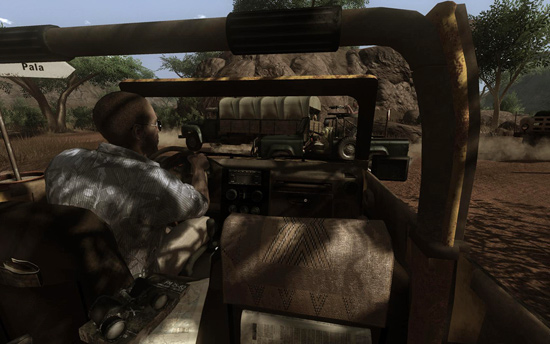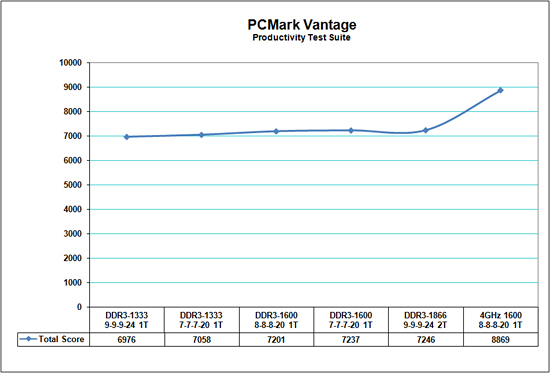Lab Update - Patriot Memory Viper Series DDR3-1333
by Gary Key on March 17, 2009 11:30 PM EST- Posted in
- Memory
Benchmarks –
Far Cry 2

This highly awaited title from last year has beautiful graphics, an open ended environment, and is fun to play... but the traveling between missions tends to get repetitive. If you dial up the graphics options, the game rewards with you some fantastic visuals courtesy of the Dunia Engine. The game also features the most impressive benchmark tool we have seen in a PC game. We set the performance feature set to Very High, graphics to High, and enable DX10 with AA set to 2x. The in-game benchmark tool is utilized with the Ranch Small level.


In both the average and minimum frame rate results we notice scaling rates around 1% going from DDR3-1333 C9 to DDR3-1866 C9. At stock CPU and GPU speeds, improving memory timing rates and speeds just does not matter with our particular platform. In fact, overclocking the system only results in a 3% improvement in average frame rates and 2% in minimum rates. Our GPU selection in this benchmark is the leading performance factor for determining frame rates. We had similar results in other games and only the Source based games like Left 4 Dead showed improvements above FarCry 2.
PCMark Vantage: TV and Movies -
This particular test suite concentrates on video transcoding and playback with simultaneous threads. It is one of the more demanding tasks in our test suite and results are dependent on CPU efficiency, core count, and memory bandwidth along with a fast storage system.

Scaling is linear as we increase memory speed and improve latencies with our best results occurring at DDR3-1866, at least until we overclock the system. The DDR3-1866 result is 5.6% better than our base DDR3-1333 C9 score. Improving our timings and latencies at 1333/1600 resulted in a 1% or so improvement, certainly nothing that would ever be noticed in actual usage.
PCMark Vantage: Productivity -
The productivity test suite focuses on general workloads in an office environment such as word processing, contact searches, email, web page rendering, and malware scanning. It also features simultaneous thread testing and is dependent on CPU speed, memory bandwidth, and a fast storage system.

Scaling is similar to the TV/Movies test suite with our best results occurring at DDR3-1866 until we overclock the system. The DDR3-1866 result is 3.8% better than our base DDR3-1333 C9 score and is not noticeable in actual usage. Improving our timings and latencies at 1333/1600 resulted in almost no improvement.
Quick Thoughts -
The Patriot Viper Series (PVT36G1333ELK) DDR3-1333 CAS9 6GB memory kit surprised us with its ability to scale memory speeds up to DDR3-1866 effortlessly or to operate at tight timings with very safe voltage settings. Even with the platform overclocked, the memory had no problems operating at DDR3-1600/1766 with reasonable timings and voltages.
While certainly not a memory kit that an enthusiast would need to break SuperPI or 3DMark records, it would suffice for about 95% of users needing a solid and high quality DDR3 6GB memory kit. Current pricing at Newegg shows this kit to be available for $97.99 with a $15 mail-in-rebate bringing the cost down to $82.99 with free shipping. Just to make sure we did not receive a “cherry” kit the first time from Newegg, we ordered a second kit a week later and had the exact same results with it. As such, we have no qualms about recommending this kit based on price, performance, and customer support provided by Patriot Memory.
We will not delve into our test results until the roundup. We will say that the majority of application benchmarks we have completed to date have resulted in similar patterns provided today at stock processor speeds with a single GPU. However, there is a place for high performance DDR3 memory. We will discuss and show results where it becomes an advantage shortly. In the meantime, a memory kit like the one previewed today will work just fine for most of us.










12 Comments
View All Comments
mvrx - Thursday, March 19, 2009 - link
I want my 24GB.. 4GB DDR2 modules have been available for quite a while.. Ready for the DDR3 versions. 12GB doesn't cut it for me ATM.rcr - Wednesday, March 18, 2009 - link
Why does this Kit get less points at DDR3-1600 CL7-7-7-20 1T at copying than DDR3-1600 CL8-8-8-20 1T?wicko - Wednesday, March 18, 2009 - link
Why does it seem that from these benchmarks that its not practical to do memory overclocking? Not to mention that timings seem to have more potential than the difference in clock speeds we're seeing in this update. Am I missing something?x86 64 - Wednesday, March 18, 2009 - link
Still what's the point for the average user to replace his DDR2 kit and motherboard\CPU with DDR3 1066Mhz or 1333Mhz at C9? Seriously what's the point? You can get cheap DDR2 1066Mhz with better timings while still keeping the same board and CPU.To me DDR3 and i7 are completely pointless right now unless you have money to burn. The i7 is the GTX280 of the generation, little performance gain for the average user over last generation hardware. Maybe it would be different if there were more multithreaded applications on the desktop but there just aren't. No I'm not counting audio\video encoding apps since it's not something you do all day everyday.
Also I'm surprised that Anand.com and other sites like HarOCP act satisfied with today's software. When hardware companies start slipping they get pounced on but when the software creators are lazy we act like it's the norm (capable software to match the hardware is just as important to me). I understand this is mainly a hardware site but it's just that software is so important to the big picture and it disgusts me how far behind the software part has fallen. You can have the latest cutting edge hardware but if the software isn't there it's pointless. That's how the i7 feels to me. It feels like total overkill at this point in time. If you think this will somehow rapidly change in the next few years you're fooling yourself.
erple2 - Wednesday, March 18, 2009 - link
If you already have a quad core processor, then I don't think that there is that much point to buying up an i7 system right now, unless you have money to burn. If you have a P4 (or single processor Athlon64 system), however, then there is actually a point to it. If you're looking at massive parallelization, however, there is a market. Who in the consumer market space actually needs that? I'd estimate that's about 0.01% of the market (who does CFD in their spare time???).I'm not going to comment on the software comment. Suffice it to say that multi-threaded software for generic tasks is EXTREMELY HARD to do. Ask John Carmack why Quake isn't optimized to run on quad core processors.
The0ne - Wednesday, March 18, 2009 - link
multi-threading is hard to do that is why I don't understand why everyone is so rush to be on the dual/quad bandwagon. Sure you have the hardware but what's making use them and making use of them EFFECTIVELY and EFFICIENTLY? You have server apps that have been programmed to do that but commercial?All these bloated commercial software are a joke to me really. Yes, you can justify a portion of them taking chunks of gigabyte but come on. Maybe I'm just a little disappointed because coming from embedded programming is different, which it didn't use to be. More efficient programming, less resources used and no need for giga-cpu configuration to run your web browser.
Having said that however,I thought being a enthusiast means you do what you love doing even if you go broke or have no purpose for the PC. Kinda like fixing up your car, painting toys, drawing, etc. Enthusiast aren't you average Joe, they do it because they love doing it.
I build PCs not to use them but for the joy of building, customizing and testing. That's enthusiast to me :)
x86 64 - Thursday, March 19, 2009 - link
Funny you should mention efficient software that uses less resources. I was thinking about an article I read where Microsoft was bragging that they had coded a Windows Vista derived kernel that ran on something like 60MB RAM with the rest picking up around 300MB. What happened to that? Why do we have this beast in Vista\Win 7 that idles at 1.5GB? Then again it's not only MS but just about any mainstream commercial application you can think of. They come out so bloated I wouldn't even consider installing it let alone actually paying money for it.You're right it IS about having fun and building\benching and just enjoying the technology, no question about it. It's just that even my "aging" E8400\8800GTX\680i\4GB DDR2-1200Mhz system has yet to be fully stressed or even approached it's limit. Occasionally when unpacking a large WinRaR archive or .ISO image RAM usage hit's 3GB utilization. I mean the best workout my PC gets is from a PS2 emulator. Other than that it's power is still relatively untapped. If there were more games and software that could efficiently and more importantly EFFECTIVELY use an eight thread, 6GB-12GB RAM and dual GPU setup it would actually make it worthwhile owning something like that.
Well anyways back on topic, a DDR3 kit rated 1066Mhz\1333Mhz CAS 9 is completely pointless if you ask me. I'll stick with my 4GB DDR2 PC-9600 kit I bought for $175 that will do 1150Mhz C4 or 1333Mhz C5.
x86 64 - Wednesday, March 18, 2009 - link
Well by your logic I should get a break too. My job is extremely hard. So should I get a pass when I don't feel like doing something because it's hard? I imagine designing CPU's and GPU's is extremely hard so should Intel and AMD just do a half ass job because of it?The Quake series wasn't optimized for quad cores because they didn't even exist when the last game was released. If you're talking about the 1.4.2 patch that adds support for dual cores well then I agree that coding for multiple cores is probably very hard to do when the framework has already been laid. I'm not asking these companies to go back and optimize all their software and games from 5 years ago. What I am asking is for them to add support for multiple cores when they redesign or write their new applications and games.
What's the point of having all that CPU power if it's just going to waste? I understand that the software\hardware paradigm is constantly shifting with one advancing faster than the other for periods of time but this is ridiculous. I don't ever remember software being so far behind. IMO it's in a sorry state right now.
RMSe17 - Wednesday, March 18, 2009 - link
It's great to see a low cost product performing as well as the really expensive alternatives. That being said, would you guys consider doing another X58 motherboard roundup, this time targeting the lower cost motherboards? It seems that all the reviews that I find have the best motherboard from each company compared, but I am curious as to how the "budget" X58 boards compare, especially when it comes to overclocking potential.Thanks a lot for all the reviews,
RMSe17
Gary Key - Wednesday, March 18, 2009 - link
We are working on "budget" X58 roundup right now. I will be honest, we had one ready but after receiving several new boards from MSI, Zotac, Gigabyte, and ASUS that are selling for under $230, we decided to blow it up and start over. It will go up near the end of the month after we finish up a review of the latest IG boards.